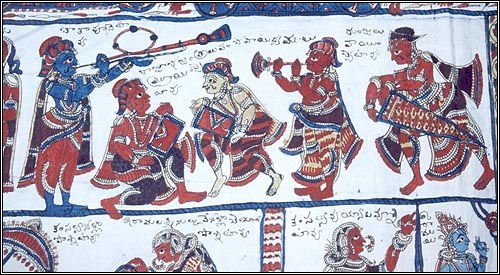Kalamkari refers to dye-painted
cloths and the technique used to create them. They are traditionally
made in small towns along the southeast coast of India, in the state
of Andhra Pradesh. Their name derives from kalam, the Persian word
for a pen-like tool used to draw outlines on the cloth, and kari
(work). The process involves washing, rinsing, soaking and bleaching
muslin, and applying mordants and dyes using natural substances like
indigo (blue), madder (red), mango bark (yellow) and palm sugar
(black).
The distinctive temple hangings, chariot
decorations and canopies of Srikalahasti typically feature Hindu
stories, and the images are often identified with text in Telegu,
the regional language.

The work done in Machilipatnam, often using
block printing in conjunction with hand painting, features more
decorative floral and vegetal designs that appealed to local
kingdoms and to an extraordinary export trade. This culminated in
European demand for Machilipatnam chintz, which derives its name
from the Hindi word chint (spotted).

|